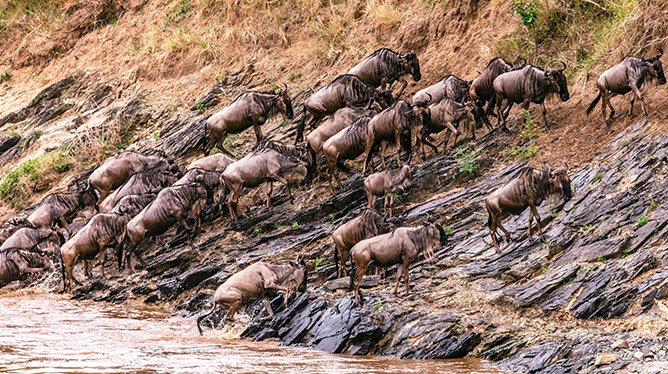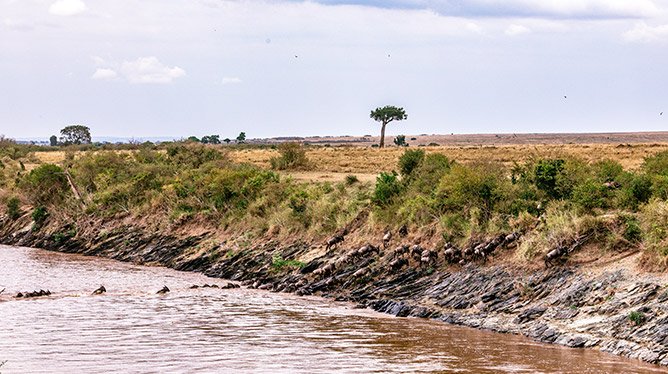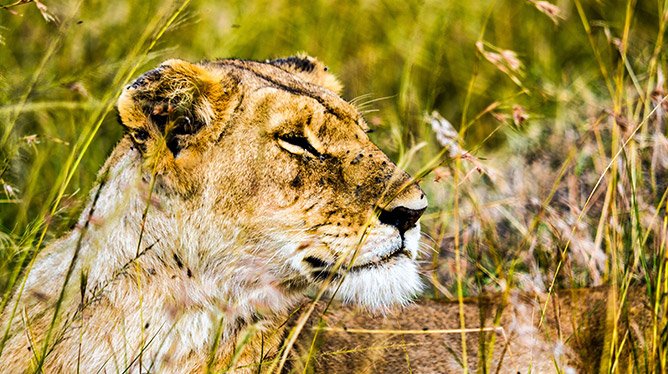

While the world witnesses incredible animal sightings, there is yet another wildlife phenomenon that many have called, “a natural wonder of the world”; the Great Annual Wildebeest Migration of East Africa. It is a never ending movement of animals across the wild plains of the Mara-Serengeti ecosystem and an absolute delight for travelers on Uganda safari tours.
Over 1.5 million Wildebeest accompanied by 300,000 Zebras, Gazelle and Topi make their way northwest from the Ngorongoro Conservation Area through the vast Serengeti plains all the way to Masai Mara in Kenya and back by the end of year. They are driven by the need to find fresh grazing plains even in the face of imminent danger.
There is nothing quite like witnessing the great Migration across Rivers such as Grumeti and Mara as a detour for a Uganda tour. The notion, “survival for the fittest” often comes into play as animals find themselves faced with the decision to keep moving or fall prey to the waiting jaws of Crocodiles, Lions, Leopards, Cheetahs, Hyenas and Wild dogs.
Although the Wildebeest migration is continuous throughout the year, it kicks off with a calving season from January to March in the Ngorongoro Conservation Area where nearly 400,000 calves are born over a period of two – three weeks. The lush grass in the area provides new calves with the well needed nutrients to prepare them for the ancient road ahead.

With their populations replenished, the herds start to shift northwards to Serengeti National Park where mating season kicks in at the end of May. When on a Uganda safari tour, cross over to Tanzania using a tourist Visa to catch the Migration at bay in Serengeti featuring thousands of Zebras and male Wildebeest battling to the death for mates.
June marks the start of grave river crossing as the dry season forces the wildebeest to continue north, crossing over River Grumeti, a famous hideout for Nile Crocodiles. Many sick, tired Wildebeest and calves fall victim to the powerful jaws of the Crocs. Join us on a Uganda tour spiced with a touch of the Great Migration crossing at Grumeti in Serengeti National Park.
Throughout July to September, hundreds of Wildebeest are lost to the Mara ravaged by Crocodiles and Lions waiting at the other side of the River for the Wildebeest that make it across. The dilemma is quite bewildering as some animals will try to get back into the water to escape the Lions on the River bank and get snatched by Crocodiles.
Do not miss out on the Mara and Talek River crossing with Ameera Africa safari for tours to Uganda. The drama is not yet over as once again, they have to cross River Mara throughout October to November to return to the Serengeti plains. The Migration here then proves to be the “greatest show on earth” presenting endless dramatic River crossings.

After the short rains of November, the herds move southwards to the outskirts of the Serengeti plains and finally to the Ngorongoro Conservation Area as the year ends. Here, the cycle starts all over again with about 8,000 calves born a day, boosting up the populations once again but sadly with little knowledge that some of them might not make it back the following year.
While this unforgettable, and even heart gripping, spectacle occurs in Tanzania and Kenya, you could always mash it with a Uganda tour especially after a Gorilla trekking safari to fully acknowledge the wildlife magic in East Africa. We guarantee that there isn’t another show on earth quite like a dramatic crossing at River Mara.
1. What are wildebeest?
They are a species of antelope commonly referred to as Gnus. They are divided into blue and black Wildebeest. The Blue species can be found throughout East and Southern Africa while the black Wildebeest can only be found in South Africa. Wildebeest can grow up to 2.4m and weigh 270kg.
2. Why do they migrate?
Wildebeest follow the direction of the rains, simply because where the rains fall, they often leave behind fresh green grass that is detrimental for survival.

3. What time of year is best to see the Migration?
With Uganda tours, the Great Migration is at its peak through June to early October as the animals cross Rivers Grumeti, Mara and Talek
4. How long is the Migration?
The Migration follows a safari loop from Ngorongoro Conservation Area through Serengeti National Park to Masai Mara game reserve and back covering nearly 1,000 kilometers.
5. What animals can I see during the Migration?
There is no limit to the abundance of animals in the Serengeti-Mara ecosystem but the common ones include; Wildebeest, Zebras, Topi, Gazelle, Lions, Cheetahs, Hyenas, Crocodiles, Leopards and Wild dogs among others.
In a nutshell, there is nothing as rewarding as witnessing one of the best wildlife shows on earth within the East African Wilderness. Contact us on today or call us on +256-393-194074 for inquiries, bookings and the best Uganda safari packages.
Leave a Reply
You must be logged in to post a comment.